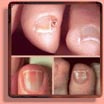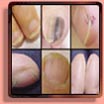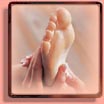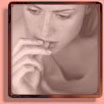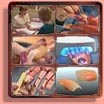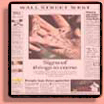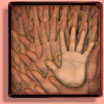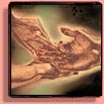|
|

HandResearch.com presents:
THE PSYCHOLOGY BEHIND NAIL BITING
- NAIL BITING BASICS -
Nail biting is usually described as a common stress-relieving habit.
The habit of biting one's fingernails or toenails occurs especially during periods of nervousness, stress or boredom.
Nail biting can also be a sign of mental or emotional disorder.
The clinical name for nail biting is 'chronic onychophagia'.
In a clinical setting the habit is often described as an act of self-mutilation.
Nail biting is more common in boys.
Nail biting occurs in all ages. Read more about the causes, treatment & prevention for various age groups:
Nail Biting in Toddlers - occurs in over 50% of toddlers
Nail Biting in Children - occurs in 28% to 33% of children ages 7-10
Nail Biting in Adolescents - occurs in 44% of adolescents
Nail Biting in Adults - 19% to 29% of young adults, 5% of older adults.
- NAIL BITING HYGIENE -
Biting the nails can result in the transportation of germs that are buried under the surface of the nail into the mouth.
So, nail biting is definitely not a good sign in the perspective of hand hygiene!
In fact, nail salons use tools that potentially affect a human in a similar way.
Nail biting also has the negative side effect of restraining the use of the hands. A compulsive nailbiter can be restricted in their ability to work (i.e. writing, typing, drawing, driving) because their hand is in their mouth.
A long-time habit of nailbiting may have detrimental effects on the substantia adamantinea of the front teeth, promoting caries in these areas.
What you should remember is this: A Kiss is healthier than a Handshake!
- TREATMENT & REMEDIES -
BEHAVIORAL THERAPY: Some patients have found behavioral therapy to be beneficial on its own or as a complement to medication.
The first part of nail biting therapy consists of Habit Reversal Training (HRT), a four part process that seeks to "unlearn" the habit of nail biting and possibly replace it with a more constructive habit.
In addition to HRT, stimulus control therapy is used to both identify and then eliminate the stimulus that frequently triggers biting urges.[5] One might also use a mouthpiece to prevent the bite.
More examples:
Nail Biting Hypnotherapy
Nail Biting Psychology
MEDICATION:
Nail biting has been shown to respond well to certain types of medication.
The medications used to treat the problem include the newest, most potent anti-depressants. These medications are also used to treat Trichotillomania and OCD and include clomipramine, fluoxetine, sertraline, paroxetine, fluvoxamine, citalopram, escitalopram, nefazodone and venlafaxine. Also, small amounts of the anti-psychotics used to treat schizophrenia such as risperidone, olazapine, quetiapine, ziprasidone, and aripiprazole can be used to augment anti-depressants. It is important to note that the use of anti-psychotics to treat nail biting does not necessarily indicate that the patient is suffering from psychosis.
More examples:
Nail Biting Remedies
Nail Biting Treatment
AWFUL-TASTING NAIL POLISH:
Available at most drugstores, this special clear nail polish can be applied to the nails. When the nail biter tries to chew their nails, it releases a bitter flavor, thus repelling the person to do so again. This treatment is one of the most common as it is available without a presciption, and it is available everywhere.
More examples:
Fingernail Biting Habit
Stop Biting Nails

FINGERNAIL NEWS

* The 'NAIL ENCYCLOPEDIA' is a branch of Medical Handanalysis.
PALM READER DIRECTORY |
THE NAIL ENCYCLOPEDIA |
ALTERNATIVE HEALTH CARE
Palm Reading | Palmistry | Hand Analysis | Hand Reading
HOME
|
